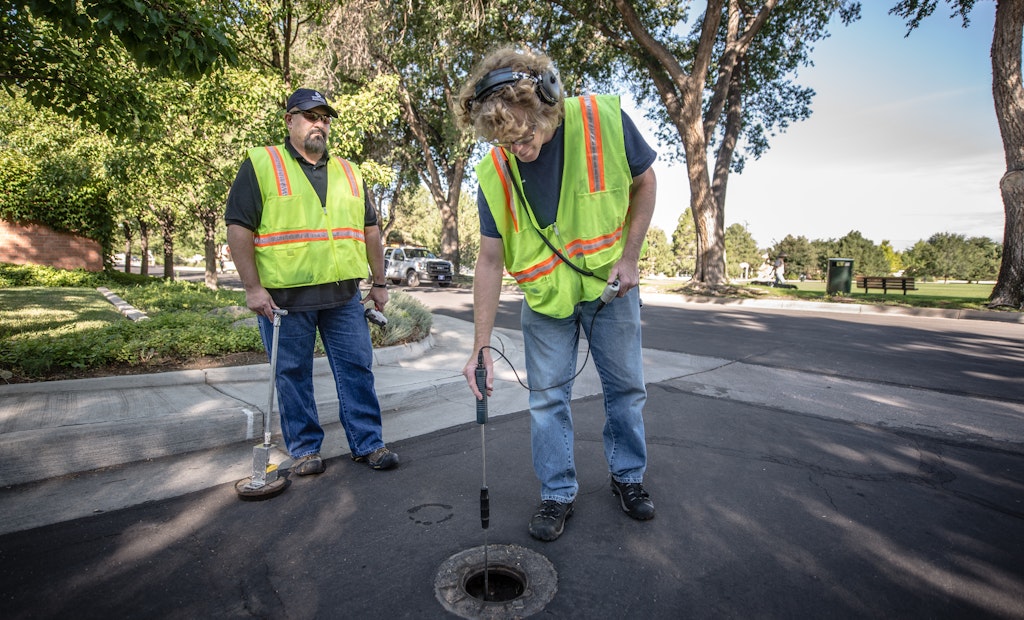
Interested in WWETT Show?
Get WWETT Show articles, news and videos right in your inbox! Sign up now.
WWETT Show + Get AlertsDetecting leaks by sound seems simple. In fact, the first underground leak detection professionals did it by simply pressing a doctor’s stethoscope to the ground. But while manufacturers of leak detection products would like you to believe that theirs is the best and only method that should be used, the truth is no one leak detection technique is guaranteed to find every leak, every time, in all situations. That idea was the basis of a seminar at the 2017 Water & Wastewater Equipment, Treatment & Transport Show last week in Indianapolis.
For the modern contractor to find success, he must open his mind to the latest technologies, and know how and when they can most effectively be utilized. According to Mark Beatty, principal owner and CEO of Utility Technologies in Ohio, a good acoustic leak detector can locate a leak that could not be found with any other technique.
Acoustics is sound within the range of the human ear. Imagine the sound air makes as it leaks from a tire. With smaller leaks, high-frequency sound is emitted.
“The more experience you have with an acoustic leak detector, the better you’ll be with it,” Beatty says. “The best technicians can recognize different noises to determine the severity of the leak, and take the environment into account.”
The key to success in finding a leak with sound depends on whether the leak is turbulent. Turbulence is generated by the friction and collision of gas molecules as they are forced from an area of higher pressure to lower pressure.
Many factors will affect the amount of turbulence (therefore sound), emitted from a leak. Not just the size of the leak, but the shape of the leak, the pressure behind it, or even the type of soil surrounding it. Whistling is a good example. Changing the shape of your mouth, and blowing harder will create different sounds. A quality acoustic leak detector will translate the high-frequency sound down to a lower frequency.
However, with an instrument so sensitive to sound, background noise can be a major problem. This includes wind, road traffic, noise created by neighboring businesses and residences, and the hum of electric transformers. According to Beatty, trying to hear a leak in a noisy environment is like trying to have a conversation at a concert.
“The closer you are to the source of the background noise, the harder it will be to hear,” he says. “Obviously the less noise there is, or the more filters your unit has, will make detecting a leak easier.”
According to Beatty, these are the simple features a contractor should look for when shopping for an acoustic leak detector:
- It should be most sensitive in a narrow frequency band to avoid the overwhelming detection of extraneous noise.
- It should provide an actual translation of the leak sound. The rushing sound of the leak should be clearly identifiable when compared to other normal operational sounds. You must be able to distinguish the difference in these sounds.
When choosing a leak detector, always consider the situation, and the factors that may affect the performance of a specific type of leak detector. Choose the instrument best suited for the specific job at hand. Beatty says this choice can come down to price:
Basic Detectors – Typically cost under $2,500
“These detectors are fine for small plumbers and municipalities that will be using them infrequently,” says Beatty. “They are typically simple to use, and can be used to detect large leaks. They aren’t going to have fine sensitivity, though, and won’t have the filters available to drown out a lot of background noise.”
Mid-Range Detectors – Typically cost $2,500 to $4,000
“These units are more sophisticated, and may come with a test rod for wet wells,” he says. “The microphones are protected from the wind, and have several filter options that allow them to be used in many different environments. They are a fit for plumbers and municipalities that deal with leak issues more frequently.”
Advanced Detectors – Typically cost $4,000 to $10,000
“These are your wireless units with many frequency options, and features for saving and replaying recordings,” says Beatty. “The typical customer is going to be the industrial plumber who advertises leak detection services, or your companies that specialize in leak detection and location. They typically do a lot of subcontracting for municipalities as well.”





